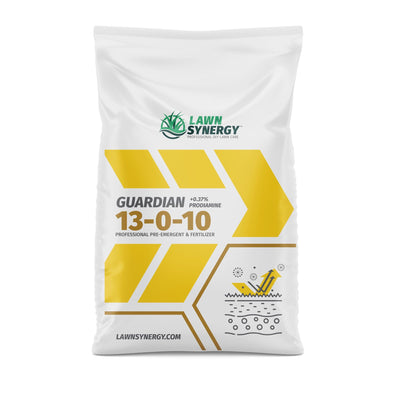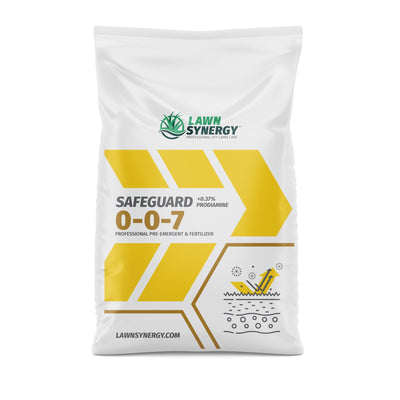You've made the decision to take your lawn seriously, and that means thinking ahead. Weed prevention isn't something you tackle after the problem shows up. It starts before the first sprout dares to break through the soil.
That's where pre-emergent herbicides come in: they're a proactive powerhouse, forming an invisible barrier to stop weeds before they ever get a chance to grow.
But before you grab the spreader, there's one smart step to consider that often gets overlooked: Should you mow before pre-emergent application?
At Lawn Synergy, we believe in making every step count.
We've taken the same professional-grade products used on estate-level properties, enhanced them with extra nutrients, and sized them for homeowners who want elite results.
And we don't just sell products—we partner with you every step of the way to make sure your lawn is dialed in perfectly.
So let's break down what mowing has to do with pre-emergent success and how to time it just right.
What this article covers:
- What Is a Pre-Emergent Herbicide and Why Does It Matter?
- Should You Mow Before Applying Pre-Emergent?
- Mowing Timing Around Lawn Treatments
- Conditions for Optimal Pre-Emergent Application
- Step-by-Step Application Tips
- Mistakes to Avoid (Based on What We See Often)
- Overseeding and Pre-Emergents: Can They Mix?
- FAQs: Fast Answers from the Pros
What Is a Pre-Emergent Herbicide and Why Does It Matter?
Pre-emergent herbicides prevent weeds by inhibiting seed germination. They form a chemical barrier in the soil, stopping weed seeds from sprouting.
Here's how they work: once applied and watered in, a pre-emergent herbicide forms a protective barrier in the upper layer of the soil.
When weed seeds start to germinate and send out their initial shoot, they hit this barrier, and that growth process stops cold. No sprout, no weed. It's proactive lawn care at its best.
But timing is everything.
If you apply too early or too late, you risk missing that narrow germination window. And if the product isn't evenly spread or watered in properly, the barrier won't be complete, and weeds will find the gaps.
Lawn Synergy's pre-emergent solutions are professional-grade and enhanced with extra nutrients, ensuring effective weed prevention for your lawn. With us, you're executing a strategy built on experience, science, and a commitment to your success.
This is why pre-emergent herbicides matter. Stopping weeds before they appear means you stay ahead, save time, and keep your lawn looking consistently sharp.
No patches. No surprises. Just clean, green turf that says, “Yes, this homeowner knows what they're doing.”

Should You Mow Before Applying Pre-Emergent?
Short answer? Yes. But let's break down why mowing before applying a pre-emergent herbicide is a smart move that can make or break your results.
When your lawn is freshly mowed (ideally 1 to 2 days before application), you're giving the herbicide a direct path to the soil, where it needs to be.
Tall grass or a layer of clippings can act like a filter, catching the product before it settles into the root zone where weed seeds live. You want that pre-emergent to create an uninterrupted barrier right in the soil, not floating on blades of grass.
Mowing beforehand also keeps things uniform. Uneven grass heights can lead to uneven application, which means spotty protection, and that's when weeds sneak in.
Think of it like prepping a canvas: a smooth, consistent surface gives you the best chance at a flawless finish.
But there's a nuance to this: don't scalp your lawn. Cutting too low can stress your grass and reduce its vigor, leaving open spaces where weeds can take hold.
Instead, stick to your regular mowing height. Clean up clippings if they're heavy, but if they're light and scattered, they can stay.
And here's the pro insight: this mowing isn't just about prep. It's part of the synergy.
Proper mowing + precision timing + a pro-grade pre-emergent like Guardian Pre-emergent 13-0-10 = total weed control success. It's a formula we've used for years, and now, we're putting that power in your hands.
Mowing Timing Around Lawn Treatments
Whether you're applying a pre-emergent herbicide or treating existing weeds with a post-emergent, the mowing window matters.
If you mow too short before applying pre-emergent, you risk stressing your grass. This weakens its natural defenses and opens the door for weeds to gain a foothold.
Think of mowing like trimming, not stripping. Stay at your standard mowing height, leaving enough blade surface for photosynthesis while reducing interference for the product to reach the soil.
Mowing too late—after the weeds have begun to germinate—can also compromise your pre-emergents' effectiveness.
Once weeds start sprouting, you're past prevention and into reaction mode. And that means more effort, more product, and often, less satisfaction.
Now, after you apply the herbicide, hold off on mowing for a few days. This gives the barrier time to activate and lock into place. Disrupting the soil too soon can literally break that protection and create weak spots for weeds to invade.

Conditions for Optimal Pre-Emergent Application
Pre-emergents are powerful, but they're not magic. For them to work effectively, the conditions need to be just right.
Here's what to check before you spread:
- Grass Dryness: Always apply to dry grass. Wet blades can cause the product to stick and clump, leading to patchy coverage. Dry turf allows for smooth, even distribution right down to the soil surface, where it matters most.
- Soil Temperature: Timing isn’t based on the calendar but on your soil. The sweet spot for most weed seeds to germinate is when the soil hits about 55°F. That’s your signal to apply. This is why starting early spring is key, but not too early. Applying before the soil warms up won’t hurt anything, so apply before soil reaches 55°F.
- Weather Forecast: You want light watering to activate your pre-emergent herbicide, not a downpour that washes it away. Avoid applying before heavy rain. A gentle soak after application is ideal and often necessary. Some products require irrigation to activate the barrier. We always recommend checking the label, and if you're unsure, ask us.
Step-by-Step Application Tips
Follow these step-by-step tips to set your lawn up for weed-free success:
1. Mow 1–2 Days Before Application
Give your lawn a clean, even cut, but don't scalp it.
The goal is to reduce grass height so the herbicide can reach the soil effectively. Stick to your regular mowing height, and if the clippings are thick, bag or rake them to avoid blocking the product.
This simple prep ensures the herbicide makes solid soil contact, forming a consistent barrier against weeds.
2. Check the Weather Forecast
You're looking for dry conditions during application and a light watering window within the next 24–48 hours.
Avoid days with high winds (to prevent drift) or heavy rain (which can wash the product away before it sets in). Timing here is everything, and a little weather watch can go a long way.
3. Apply to Dry Grass
Your lawn should be completely dry at the time of application. Wet blades can cause granules or spray to cling unevenly, reducing coverage.
A dry surface allows for smooth, even distribution, which means stronger weed prevention.
4. Apply Evenly and Carefully
Use a calibrated spreader for granules or a sprayer if you're applying a liquid formulation. Walk at a steady pace and overlap your passes slightly to avoid missing spots.
Think of this like painting a wall—you want complete, consistent coverage with no gaps.
5. Lightly Water It In (If Required)
Most pre-emergents need light watering soon after application to activate and bind the product to the soil.
This doesn't mean flood the lawn—just enough to help the product move slightly into the soil's surface.
Be sure to read the product label for specifics. Not all formulas are the same, and overwatering can reduce effectiveness.

6. Hold Off on Mowing for a Few Days
Once applied, let the product settle. Avoid mowing for 3–5 days to prevent disturbing the soil barrier you've just created. The barrier needs to stay intact to block weed seed germination.
7. Sync Up With Support (Seriously)
Not sure what product to choose? Don't know your soil temps? That's where we come in. Reach out to us for free expert advice. We'll help you figure out what to apply, when to apply it, and how to make sure your lawn thrives.
8. Repeat Seasonally
Pre-emergents aren't one-and-done. Apply in early spring and again in early fall to keep seasonal weeds from breaking through. This seasonal approach is key to long-term success.
Mistakes to Avoid (Based on What We See Often)
Here are the most common pre-emergent pitfalls we see, plus how to avoid them:
1. Mowing Too Low or Skipping Mowing Altogether
Cutting your lawn too short before applying pre-emergent weakens the grass and exposes the soil, creating open land for weeds.
On the flip side, skipping mowing means the product can sit on the leaf surface instead of reaching the soil. Aim for a balanced, healthy mow 1–2 days before you apply.
2. Applying Pre-Emergent Too Late
If you wait until weeds are visible, it's already game over for pre-emergents. They're not designed to kill existing weeds—they prevent new ones from sprouting.
If you're seeing weeds, you'll need a post-emergent. For true prevention, timing is everything.
3. Watering Too Much—or Not at All
Watering activates most pre-emergents. But drowning the lawn risks washing away the product before it sets. Skipping watering will cause the barrier to fail.
Read the label and apply just enough water to settle the product into the top layer of soil. Still unsure? Reach out to us. We'll guide you based on the product and your lawn conditions.
4. Uneven Application
This is huge. Uneven spreading leads to patchy control. You'll end up with weed-free zones right next to problem spots.
Calibrate your lawn spreader, overlap slightly, and take your time. Our team can walk you through the equipment settings if you need help.
We also have guides on “Is pre emergent safe for dogs?” and “Is pre emergent toxic?” to answer any of your other concerns.

Overseeding and Pre-Emergents: Can They Mix?
Most pre-emergents block seed germination, so avoid applying them when planning to overseed. Instead, plan your overseeding schedule accordingly. Lawn Synergy can help you get the timing right for both overseeding and pre-emergent application.
FAQs: Fast Answers from the Pros
Can I mow after applying pre-emergent?
Wait a few days after application before mowing to allow the herbicide to settle into the soil.
Do I need to water it in?
Yes, lightly water the lawn after application unless the product label advises otherwise.
What's the best time of year for pre-emergent?
Apply pre-emergent in early spring when soil temperatures reach around 55°F.
Can I apply in flower beds?
Yes, but ensure the pre-emergent is labeled safe for use in flower beds.
Conclusion
Mowing before applying pre-emergent herbicide enhances its effectiveness by ensuring better soil contact.
Proper timing, application, and follow-up are key to a healthy, weed-free lawn.
You're not doing this alone. We help you plan, prep, apply, and time every treatment with confidence.
Whether you're new to pre-emergents or looking to level up your routine, we're the synergy that turns potential into results.
Explore our pre-emergent products today and connect with our expert team to time your application perfectly. Your lawn deserves more than guesswork—it deserves Lawn Synergy.
Explore our pre-emergent products and get free expert support to time it right.
If you want to learn more, check out these articles below:
-
Does Pre-Emergent Kill Clover
- Are Pre-Emergent Herbicides Safe
- How Long Does Pre Emergent Last?
- Is It Too Late for Pre Emergent?
- Does Pre Emergent Work?
- Can I Put Pre Emergent on Wet Grass?
- How Long Does Barricase Pre Emergent Last?
- How Long After Pre Emergent Can I Seed?
- When to Water After Pre Emergent
- Is Weed and Feed a Pre Emergent?
- Best Pre-Emergent for North Texas
- Best Pre-Emergent for Poa Annua
- Best Pre-Emergent for Arizona
- The Best Pre-Emergent for Zoysia
- Best Pre-Emergent for Bermuda Grass in Texas



